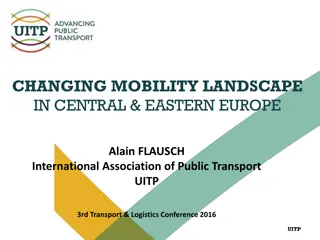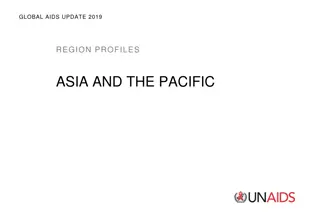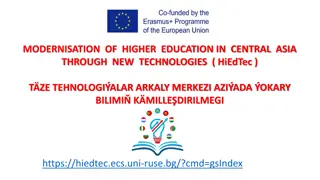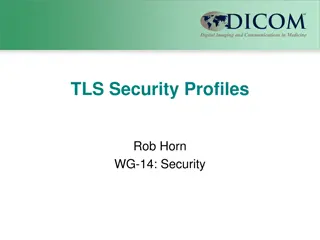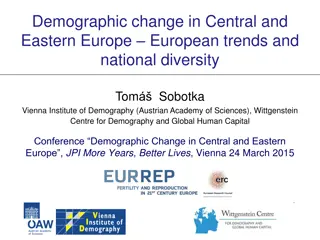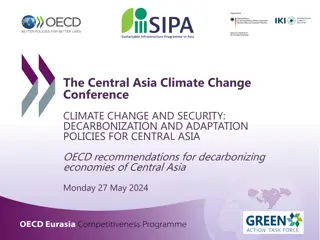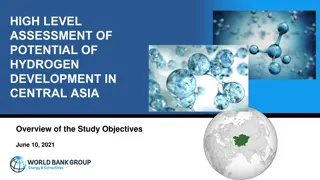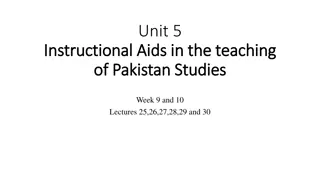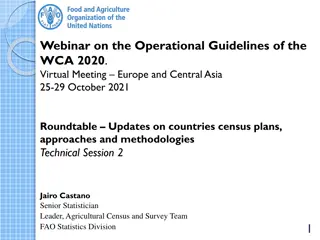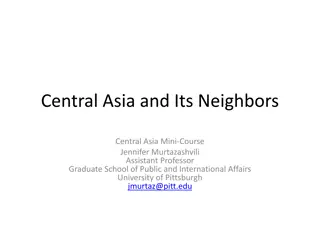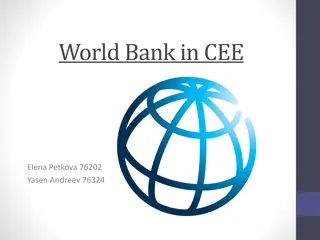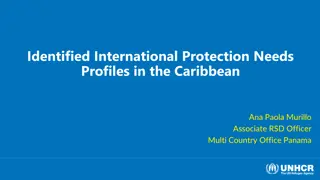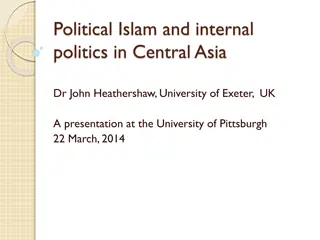Global AIDS Update 2019: Eastern Europe and Central Asia Region Profiles
This update provides insights into HIV incidence trends, new infections, AIDS-related deaths, and prevalence among key populations in Eastern Europe and Central Asia from 2000 to 2018. It highlights changes in HIV rates among specific groups such as people who inject drugs, sex workers, and men who have sex with men. The data reveals fluctuations in new infections and deaths over the years, emphasizing the need for targeted interventions in the region.
Download Presentation

Please find below an Image/Link to download the presentation.
The content on the website is provided AS IS for your information and personal use only. It may not be sold, licensed, or shared on other websites without obtaining consent from the author. Download presentation by click this link. If you encounter any issues during the download, it is possible that the publisher has removed the file from their server.
E N D
Presentation Transcript
GLOBAL AIDS UPDATE 2019 REGION PROFILES EASTERN EUROPE AND CENTRAL ASIA
HIV incidence trends among key populations, eastern Europe and central Asia, 2010 2018 2.5 People who inject drugs 2.0 Sex workers Gay men and other men who have sex with men 1.5 Per cent 1.0 0.5 Note: Countries included are: Armenia, Azerbaijan, Belarus, Georgia, Kazakhstan, Kyrgyzstan, Republic of Moldova, Tajikistan, Ukraine and Uzbekistan. Shadows indicate the uncertainty in the calculations which has not been estimated. 0 2010 2011 2012 2013 2014 2015 2016 2017 2018 Source: UNAIDS special analysis, 2019.
Number of new HIV infections and AIDS-related deaths, and incidence-prevalence ratio eastern Europe and central Asia, 2000 2018 New HIV infections AIDS-related deaths Incidence-prevalence ratio 180 000 25 60 000 Percentage change in new HIV infections since 2010 +29% Percentage change in AIDS- related deaths since 2010 +5% 2018 Number of AIDS-related deaths Number of new HIV infections 160 000 Incidence- prevalence 50 000 Incidence-prevalence ratio 20 140 000 120 000 40 000 ratio 15 100 000 9.0% [8.2 9.5%] 30 000 80 000 10 60 000 20 000 40 000 5 3 10 000 20 000 0 0 0 2000 2010 2018 2000 2010 2018 2000 2005 2010 2015 2018 New HIV infections AIDS-related deaths Incidence-prevalence ratio Target value Source: UNAIDS 2019 estimates.
Percentage change in new HIV infections, by country, eastern Europe and central Asia, 2010 2018 140 129 120 100 88 80 60 56 Per cent 40 35 32 20 5 0 -9 -11 -20 -22 -30 -40 -39 -49 -60 Kazakhstan North Macedonia Tajikistan Uzbekistan Ukraine Montenegro Kyrgyzstan Republic of Moldova Bosnia and Herzegovina Belarus Armenia Georgia Source: UNAIDS 2019 estimates.
HIV prevalence among key populations Distribution of new HIV infections (aged 15 49 years), by population group Eastern Europe and central Asia, 2014 2018 Eastern Europe and central Asia, 2018 Remaining population 1% 35 Sex workers 7% 30 25 Clients of sex workers and sex partners of other key populations 29% Per cent 20 15 Peoplewho inject drugs 41% 10 7.4 6.2 5 2.0 2.0 1.9 0 Gay men and othermen who have sex with men 22% Sex workers, n = 13 Gay men and other men who have sex with men, n = 13 People who inject drugs, n = 14 Transgender people, n = 1 Prisoners, n = 11 Source: UNAIDS Global AIDS Monitoring, 2014 2018. Source: UNAIDS special analysis, 2019.
Estimated size of key populations, eastern Europe and central Asia, 2018 Country National adult population (15+) Sex workers Sex workers as per cent of adult population (15+) Gay men and other men who have sex with men Gay men and other men who have sex with men as per cent of adult population (15+) People who inject drugs People who inject drugs as per cent of adult population (15+) Transgender people Transgender people as per cent of adult population (15+) Prisoners Prisoners as per cent of adult population (15+) Albania 2 432 000 3000 0.13 Armenia 2 345 000 4600 0.2 16 000 0.69 9000 0.38 Azerbaijan 7 610 000 32 000 0.42 24 000 0.31 60 000 0.79 Georgia 3 150 000 19 000 0.59 North Macedonia 1 741 000 6800 0.39 2300 0.13 Tajikistan 5 889 000 18 000 0.3 Ukraine 37 062 000 87 000 180 000 0.48 350 000 0.95 National population size estimate Local population size estimate Insufficient data No data The regions for which the local population size estimate refers are as follows: Ukraine: All regions except Luhansk region and Sevastopol Source: Global AIDS Monitoring, 2018; United Nations, Department of Economic and Social Affairs, Population Division. World population prospects: the 2017 revision. 2018 (custom data acquired via website).
HIV testing and treatment cascade, eastern Europe and central Asia, 2018 1.8 1.6 Gap to reaching the first 90: 306 000 1.4 Gap to reaching the first and second 90s: 731 000 1.2 Number of people living with HIV (million) Gap to reaching all three 90s: 740 000 1.0 0.8 72% [64 81%] 0.6 38% [30 44%] 0.4 29% [26 33%] 0.2 0 People living with HIV who know their status People living with HIV on treatment People living with HIV who are virally suppressed Source: UNAIDS special analysis, 2019; see annex on methods for more details.
909090 country scorecard: eastern Europe and central Asia, 2018 First 90: percentage of people living with HIV who know their HIV status Second 90: percentage of people living with HIV who know their status and who are on treatment Third 90: percentage of people living with HIV on treatment who have suppressed viral loads Viral load suppression: percentage of people living with HIV who are virally suppressed All ages Women (15 years and older) Men All ages Women (15 years and older) Men All ages Women (15 years and older) Men All ages Women (15 years and older) Men (15 years and older) (15 years and older) (15 years and older) (15 years and older) Eastern Europe and central Asia 72 85 65 53 54 51 77 78 77 29 36 25 Albania Armenia Azerbaijan Belarus Bosnia and Herzegovina Georgia Kazakhstan Kyrgyzstan Montenegro Republic of Moldova North Macedonia Russian Federation Tajikistan Turkmenistan Ukraine Uzbekistan 62 72 71 74 65 78 60 69 73 72 73 83 75 69 87 80 44 49 41 79 77 80 78 70 71 67 40 43 38 59 88 68 55 54 59 50 62 83 61 56 49 61 84 66 64 73 63 91 95 71 69 72 67 80 61 54 73 60 90 85 65 68 93 77 86 87 68 76 85 62 63 92 76 85 42 38 30 38 26 46 41 47 41 38 31 41 42 31 21 38 22 47 >95 79 52 61 41 >95 77 >95 >95 58 80 47 80 84 70 67 72 63 31 48 20 71 89 59 73 75 72 93 93 93 48 62 40 90 90 90: Viral load suppression: 90% and above 85 89% 70 84% 50 69% Less than 50% 73% and above 65 72% 40 64% 25 39% Less than 25% Source: UNAIDS special analysis, 2019.
Viral load suppression among adults (15 years and older) living with HIV, by sex, eastern Europe and central Asia, 2018 100 90 80 70 60 Per cent 50 40 30 20 10 0 Armenia Belarus Georgia Kazakhstan Kyrgyzstan Montenegro Republic of North Macedonia Tajikistan Ukraine Moldova Females Males Source: UNAIDS special analysis, 2019.
Knowledge of status among key populations, eastern Europe and central Asia, 2016 2018 100 90 80 70 60 Per cent 50 40 30 20 10 0 Armenia Azerbaijan Belarus Georgia Kazakhstan Kyrgyzstan Ukraine Republic of Moldova Tajikistan North Macedonia Sex workers Gay men and other men who have sex with men People who inject drugs Note: Data shown come from surveys, which are typically conducted in areas with high prevalence and needs and may not be nationally representative. Source: Global AIDS Monitoring, 2016 2018.
Percentage of key populations who reported receiving at least two prevention services in the past three months, eastern Europe and central Asia, 2016 2018 100 90 80 70 60 Per cent 50 40 30 20 10 0 North Macedonia Republic of Moldova Tajikistan Armenia Belarus Kazakhstan Sex workers Gay men and other men who have sex with men People who inject drugs Transgender people Note 1: The use of an asterisk (*) indicates that data for marked countries come from programme data (which tends to show higher values due to the use as a denominator of the number of key population members that are linked to the programme) and not from a survey. Note 2: Possible prevention services received among sex workers, gay men and other men who have sex with men and transgender people: condoms and lubricant, counselling on condom use and safe sex, and testing of STIs. Possible prevention services received among people who inject drugs: condoms and lubricant, counselling on condom use and safe sex, and clean needles or syringes. Source: Global AIDS Monitoring, 2016 2018.
Percentage of ever-married or partnered women aged 15 49 years who experienced physical and/or sexual violence by an intimate partner in the past 12 months Percentage of men and women aged 15 49 years with discriminatory attitudes towards people living with HIV Eastern Europe and Central Asia, most recent data, 2016 2017 Eastern Europe and Central Asia, 2013 2018 People who would not buy vegetables from a shopkeeper living with HIV 20 100 People who think children living with HIV should not be allowed to attend school with children not living with HIV 18 90 16 80 14 70 12 60 Per cent Per cent 10 50 8 40 6 30 4 20 2 10 0 0 Turkmenistan Kyrgyzstan Kazakhstan Tajikistan Albania Armenia Montenegro Tajikistan Armenia Note: Data for Kazakhstan, Kyrgyzstan, Tajikistan and Turkmenistan are for female respondents only. Source: Population-based surveys, 2016 2017. Source: Population-based surveys, 2013 2018, countries with available data.
HIV resource availability, by source, eastern Europe and central Asia, 2010 2018, and projected resource needs by 2020 1800 1600 1400 1200 US$ (million) Domestic (public and private) 1000 United States (bilateral) Global Fund Other international Resource needs (Fast-Track) 800 600 400 200 0 2010 2011 2012 2013 2014 2015 2016 2017 2018 2020 Note: Data from the Russian Federation is not included in this analysis. Source: UNAIDS 2019 resource availability and needs estimates.


